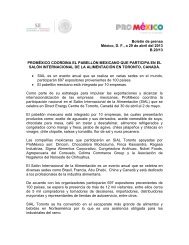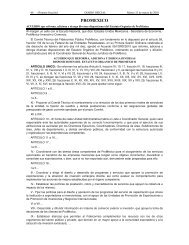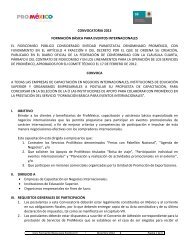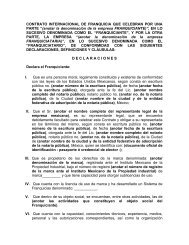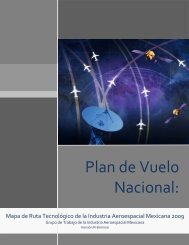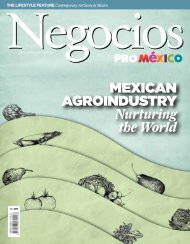MINING IN MEXICO S - ProMéxico
MINING IN MEXICO S - ProMéxico
MINING IN MEXICO S - ProMéxico
You also want an ePaper? Increase the reach of your titles
YUMPU automatically turns print PDFs into web optimized ePapers that Google loves.
the lifestyle feature Editorial Industry<br />
About The Art Of Book Publishing<br />
A group of new Mexican publishers, with leaders who are only around thirty<br />
years old, are looking to stake their place in the Spanish-language publishing<br />
industry. Competing against the large publishing houses, especially those from<br />
Spain, they want to show that they can find niches of cultural consumption that<br />
reconcile cultural quality with financial viability.<br />
By JOSÉ MIGUEL TOMASENA<br />
In their words: instead of bestsellers, long sellers; instead of a Dan<br />
Brown or Steig Larsson publishing frenzy, a slow-cooked catalog of<br />
consistent quality; instead of fashion, literary merit; instead of the big<br />
bookstores that churn out constant novelties, distribution networks<br />
that reach their readers.<br />
Publishers like Almadía, Sexto Piso, Tumbona or Textofilia were<br />
not on the radar in Mexico ten years ago. The success of Oaxaca-based<br />
Almadía shows that the fresh approach is a result of its focus on design<br />
–its colorful covers include a window onto the inside– and a catalog<br />
that combines acclaimed writers such as Sergio Pitol (winner of the<br />
Cervantes prize), Juan Villoro or<br />
Margo Glantz, with a generation<br />
of young writers who are coming<br />
to the fore, such as Bernardo Esquinca,<br />
Alberto Chimal or Daniela<br />
Tarazona.<br />
Tumbona Ediciones, founded<br />
in 2005, has published a collection<br />
of provocative diatribes called Versus,<br />
including some of the funniest<br />
and most ingenious writings found<br />
among modern essay, with arguments against poetry, against television,<br />
against work and against copyright.<br />
A report by UNESCO shows that Mexicans read an average of 2.9<br />
books per year. However, a careful look at the 2006 National Reader<br />
Survey carried out by the National Council for Culture and the Arts<br />
(Conaculta) shows that a specific group of Mexicans with a high level<br />
of income and education read a lot more. Those with university-level<br />
education read an average of 5.1 books per year and taking into account<br />
income levels, the upper-middle and upper socioeconomic groups read<br />
7.2 books per year.<br />
This latest wave of publishers<br />
aiming to create high-quality catalogs,<br />
realize that this is their niche.<br />
“It would be crazy to try to compete<br />
with Grupo Planeta or Mondadori,<br />
because their market is very well<br />
defined,” says Ricardo Sánchez, Editor<br />
in Chief of Textofilia, a new publishing<br />
house specializing in classical<br />
poetry and contemporary art.<br />
Their work involves a slow and careful<br />
process of selecting books to create a<br />
long-term catalog, setting up independent<br />
distribution networks and buying the rights<br />
to high quality works that have not been<br />
published in Spanish.<br />
On The Art Of Creating A<br />
Catalog<br />
Diego Rabasa, a partner in Sexto<br />
Piso, a Mexican publishing house<br />
that produces around twenty-five<br />
works a year and exports its catalog<br />
to South America and Spain, believes<br />
that the publishing business gives results<br />
over the long term. The keys to<br />
success: quality and consistency.



